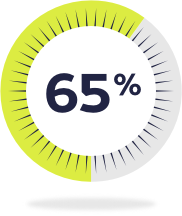DIAGNOSING ADULT ADHD
Adult ADHD is prevalent but underdiagnosed1,2
- ADHD is more than just a "childhood disorder"—it occurs across the lifespan and impacts people of all ages1,2
- Data support that ADHD remains underdiagnosed and consequently untreated in adult populations3,4
Diagnosing Adult ADHD
ADHD is now recognized as one of the most common psychiatric diagnoses in adults5
The prevalence of ADHD among the adult patient population in the US has been estimated at up to 5%5
- That’s approximately 10 million American adults diagnosed with ADHD
ADHD often persists into adulthood1,3

While ADHD was previously classified as a “childhood disorder,” recent long-term studies suggest that up to 65% of pediatric patients diagnosed will continue to have ADHD as adults.1,3
Gender differences in adult ADHD
- ADHD is more common in males during childhood, but as patients age, the gender ratio narrows6,7
- In child/adolescent clinics, approximately 80% of ADHD patients are male, whereas in adult clinics, it’s closer to 50%6
- Literature shows that adult ADHD may be underdiagnosed in women, who often present with subtler internalizing symptoms (eg, inattentiveness) vs more obvious externalizing symptoms (eg, impulsiveness and hyperactivity)8
ADHD is associated with substantial social and economic costs3
The economic burden of adult ADHD in the US is estimated at up to $266 billion annually.3 Associated costs include:
- Medical/health-related expenses3
- Productivity losses from work and academic settings:
- Productivity and income loss due to adult ADHD is estimated at up to $137 billion4
- Up to 25% of college students receiving disability services are diagnosed with ADHD9
- Studies have found that employees with ADHD are 60% more likely to be fired and 18 times more likely to exhibit “behavior problems” at work10
ADHD is also associated with a higher risk for mood disorders—a psychosocial impact that can also have indirect economic consequences.3
Adult ADHD Symptoms
Signs and symptoms of adult ADHD
Common indicators of ADHD in adults include:
- Restlessness and trouble relaxing11,12
- Disorganization in the workplace or in academic settings11,12
- Difficulties with financial management (eg, trouble paying bills and setting financial priorities; compulsive shopping)13
- Inability to follow through on tasks and to meet deadlines11
- Extraversion (particularly in those with hyperactive-impulsive ADHD)14
- Significant difficulties in social relationships13
- Impulsivity and risky behavior13
Although it can also occur in children with ADHD, emotional dysregulation is a core symptom in adults with the disorder, and may correlate to symptom severity 15
- Deficits in emotional self-regulation have been posited as a primary executive functioning deficit in adult ADHD, and include shifting affect, mood lability, and emotional overreaction16
- Over 30% of adolescents and adults report that emotional lability is the most impairing aspect of their ADHD17
It is important to recognize that symptomatic presentation of ADHD can change from childhood to adulthood6,18
- Adults who have ADHD are less likely than children to present as hyperactive/restless vs inattentive6,18
- In adults, symptoms of inattention may be manifested as difficulties in carrying out tasks such as keeping appointments or meeting deadlines11
Functional impairments associated with ADHD may also evolve as patients transition to adulthood10
- Academic failure in childhood underemployment; inability to advance in socioeconomic status10,18
- Childhood injuries resulting from hyperactivity reckless driving and car wrecks10,19
- Experimentation with drugs or alcohol substance use disorder19,20
- Patterns of impulsive behavior poor decision-making leading to unintended pregnancies and sexually transmitted infections10,19
Diagnostic Criteria
Diagnostic criteria for adult ADHD
Per DSM-5 criteria, in order to be diagnosed with ADHD, adults must exhibit at least 5 symptoms of inattention and/or hyperactivity/impulsivity that have persisted for at least 6 months and that negatively impact social and academic/occupational functioning.12
ADHD symptoms of inattention in adults11,12,19
- Makes careless mistakes/lacks attention to detail (eg, overlooks or misses details; work is inaccurate)
- Lacks sustained attention in tasks or play activities (eg, difficulty remaining focused during lectures or conversations, or when reading lengthy writing)
- Has difficulty listening
- Fails to follow through on tasks and instructions (eg, does not finish workplace assignments)
- Has difficulty with organization, punctuality, and planning (eg, deadlines)
- Has temporary hyperfocus for highly important tasks, but loses focus on more mundane tasks of daily living (eg, returning phone calls, paying bills, keeping appointments)
- Gets lost in the details
- Loses the things necessary for tasks or activities (eg, wallet, cellphone, important paperwork)
ADHD symptoms of hyperactivity/impulsivity in adults11,12,19
- Talks too much and too loudly
- Has difficulty with quiet, leisure activities
- Inner restlessness; paces (eg, uncomfortable being still for an extended period of time in restaurants or at the office; perceived by others as difficult to keep up with)
- Acts without thinking
- Unable to postpone gratification
- Has difficulty waiting turn (eg, while waiting in line)
- Intrudes on others (eg, takes over what others are doing)
- Seeks sensations and takes risks
Combined (inattentive/hyperactive-impulsive)
Shows symptoms of both inattention and hyperactivity for the past 6 months.12
This is not the complete diagnostic criteria. Please see DSM-5 for full diagnostic criteria. It is important to note that diagnosis should be based on a complete history of the patient.
Self-reporting of symptoms may be problematic in adult ADHD11,21
Self-reporting of ADHD symptoms in adults has been shown to be less accurate than reports from family, peers, and colleagues regarding issues with employment, relationships, and social activities.11,21 The DSM-5 therefore recommends obtaining collateral information from a friend or family member with long-term knowledge of the patient when making a diagnosis of adult ADHD.11,12
Key Takeaways
- Up to 65% of patients diagnosed with ADHD in childhood/adolescence still have the disorder in adulthood1,3
- The presentation of ADHD is different in adults vs children; symptoms of inattention become more prominent than those of hyperactivity11,18
UP NEXT:
REFERENCES
- Geffen J, Forster K. Treatment of adult ADHD: a clinical perspective. Ther Adv Psycopharmacology. 2018;8(1):25-32.
- Kolar D, Keller A, Golfinopolous M, et al. Treatment of adults with attention-deficit/hyperactivity disorder. Neuropsychiatr Dis Treat. 2008;4(2):389-403.
- Katzman MA, Bilkey TS, Chokka PR, Fallu A, Klassen LJ. Adult ADHD and comorbid disorders: clinical implications of a dimensional approach. BMC Psychiatry. 2017;17:302.
- Bitter I, Mohr P, Balogh L, et al. ADHD: a hidden comorbidity in adult psychiatric patients. Atten Defic Hyperact Disord. 2019;11(1):83-89.
- National Institute of Mental Health. Attention-Deficit/Hyperactivity Disorder (ADHD). https://www.nimh.nih.gov/health/statistics/attention-deficithyperactivity-disorder-adhd. Accessed August 20, 2021.
- Franke B, Michelini G, Asherson P, et al. Live fast, die young? A review on the developmental trajectories of ADHD across the lifespan. Eur Neuropsychopharmacol. 2018;28;1059-1088.
- Young S, Adamo N, Ásgeirsdóttir BB, et al. Females with ADHD: an expert consensus statement taking a lifespan approach providing guidance for the identification and treatment of attention-deficit/hyperactivity disorder in girls and women. BMC Psychiatry. 2020;20:404. doi: 10.1186/s12888-020-02707-9.
- Quinn PO, Madhoo M. A review of attention-deficit/hyperactivity disorder in women and girls: uncovering this hidden diagnosis. Prim Care Companion CNS Disord. 2014;16(3):PCC.13r01596.
- Green AL, Rabiner DL. What do we really know about ADHD in college students? Neurotherapeutics. 2012;9(3):559-568.
- Barkley RA, Fischer M. The Milwaukee longitudinal study of hyperactive (ADHD) children. In: Hechtman L, ed. Attention Deficit Hyperactivity Disorder: Adult Outcome and Its Predictors. NY, USA: Oxford University Press; 2016:63-104.
- Volkow ND, Swanson JM. Adult attention-deficit disorder. N Engl J Med. 2013;369(20):1935-1944.
- American Psychiatric Association. Diagnostic and Statistical Manual of Mental Disorders. 5th ed. Washington, DC: American Psychiatric Publishing; 2013.
- Brod M, Pohlman B, Lasser R, Hodgkins P. Comparison of the burden of illness for adults with ADHD across seven countries: a qualitative study. Health Qual Life Outcomes. 2012;10:47. doi: 10.1186/1477-7525-10-47.
- Gomez R, Corr PJ. ADHD and personality: a meta-analytic review. Clin Psychol Rev. 2014;34:376-388.
- Beheshti A, Chavanon M-L, Christiansen H. Emotional dysregulation in adults with attention deficit hyperactivity disorder: a meta-analysis. BMC Psychiatry. 2020;20:120. doi: 10.1186/s12888-020-2442-7.
- Adler LA, Silverstein MJ. Emotional dysregulation in adult ADHD. Psychiatr Ann. 2018;48(7):318-322.
- Dodson W. Emotional dysregulation and rejection sensitivity. Attitude Magazine. Published online October 9, 2016. Accessed April 18, 2021.
- Fredriksen M, Dahl AA, Martinsen EW, Klungsoyr O, Faraone SV, Peleikis DE. Childhood persistent ADHD symptoms associated with educational failure and long-term occupational disability in adult ADHD. Atten Defic Hyperact Disord. 2014;6(2):87-99.
- Kooij JJS, Bijlenga D, Salerno L, et al. Updated European Consensus Statement on diagnosis and treatment of adult ADHD. Eur Psychiatry. 2019;56:14-34.
- Bukstein O. Substance abuse in patients with attention-deficit/hyperactivity disorder. Medscape J Med. 2008;10(1):24.
- Fields SA, Johnson WM, Hassig MB. Adult ADHD: addressing a unique set of challenges. J Fam Pract. 2017;66(2):68-74.




